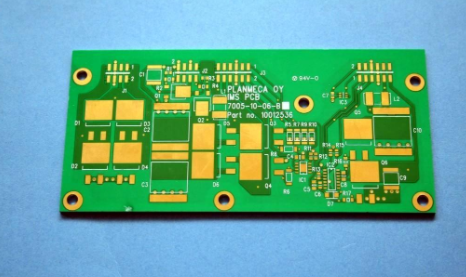According to the characteristics of horizontal electroplating, it is an electroplating method in which the printed circuit board is placed from a vertical type to a parallel plating liquid surface. At this time, the printed circuit board is the cathode, and some horizontal electroplating systems use conductive clamps and conductive rollers for current supply. From the convenience of the operating system, it is common to use the roller conductive supply method. The conductive roller in the horizontal electroplating system not only serves as the cathode, but also has the function of conveying the printed circuit board. Each conductive roller is equipped with a spring device, the purpose of which can be adapted to the electroplating needs of printed circuit boards of different thicknesses (0.10-5.00mm). However, during electroplating, all parts in contact with the plating solution may be plated with a copper layer, and the system will not work for a long time. Therefore, most of the currently manufactured horizontal electroplating systems design the cathodes to be switchable to anodes, and then use a set of auxiliary cathodes to electrolytically dissolve the copper on the plated rollers. For the sake of maintenance or replacement, the new electroplating design also considers the parts that are prone to wear and tear to facilitate removal or replacement. The anode adopts an array of adjustable size insoluble titanium baskets, which are placed on the upper and lower positions of the printed circuit board, and are equipped with a spherical shape of 25mm in diameter and a phosphorus content of 0.004-0.006% soluble copper. The distance between the cathode and the anode It is 40mm.

The flow of the plating solution is a system composed of pumps and nozzles, which makes the plating solution flow alternately and rapidly in the closed plating tank back and forth, up and down, and can ensure the uniformity of the plating solution flow. The plating solution is sprayed vertically to the printed circuit board, forming a wall jet vortex on the surface of the printed circuit board. The ultimate goal is to achieve rapid flow of plating solution on both sides of the printed circuit board and through holes to form eddy currents.
In addition, a filter system is installed in the tank, and the filter mesh used is 1.2 microns to filter out the particulate impurities generated during the electroplating process to ensure that the plating solution is clean and pollution-free.
When PCB manufacturing a horizontal electroplating system, the convenience of operation and the automatic control of process parameters must also be considered. Because in actual electroplating, with the size of the printed circuit board, the size of the through-hole aperture and the required copper thickness, the transmission speed, the distance between the printed circuit boards, the size of the pump horsepower, and the nozzle The setting of the process parameters such as the direction of the current density and the level of the current density requires actual testing, adjustment and control to obtain the copper layer thickness that meets the technical requirements. It must be controlled by a computer. In order to improve the PCB production efficiency and the consistency and reliability of the quality of high-end products, the through-hole processing (including plated holes) of the printed circuit board is formed according to the process procedures to form a complete horizontal electroplating system to meet the development and launch of new products. Needs.